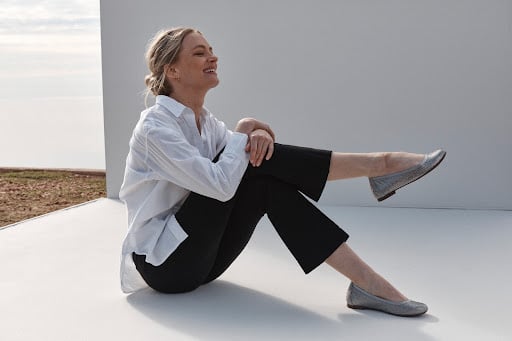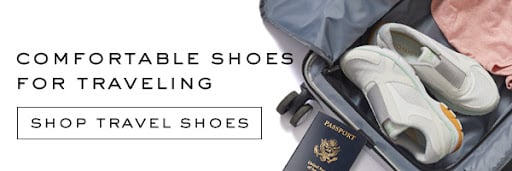We all know the feeling of slipping on a fresh pair of kicks that cradles your foot like you’re walking on clouds. It’s no surprise, then, that proper shoe fit—especially in the toe box—is key to getting that oh-so-supported feeling. And yet, most of us are walking around in shoes that don’t fit. Studies have found that up to 72% of people wear shoes that fit incorrectly.1
So why do we have such a hard time getting our shoes to fit right? And just how much room should you have in your shoe?
Turns out, there is a research-backed answer: Experts recommend between ⅜” to ½” of space between the end of your toes and the front of the shoe—roughly the width of your thumb.2 For more tips on how to find the perfect pair, read on as we dig into the science behind foot health and the proper fit.
WHAT IS THE TOE BOX AND WHY DOES IT MATTER?
First things first, let’s talk about your toe box. This is simply the part of the shoe that surrounds your toes. The importance of a properly fitting toe box can’t be overstated. Research has found that a too-tight toe box can cause a long list of foot problems, such as1:
- Foot pain
- Blisters
- Bunions, corns, and calluses
- Sores (especially for those with diabetes)
- Ingrown toenails
- Toe deformity
In childhood, a cramped toe box can even lead to improper development of the big toe joint that could require surgery to correct.3 And too-small walking shoes are not an uncommon problem—the same study also found that up to 88% of children wore shoes that were too short.
Clearly, making sure your toes have sufficient room in your shoes is one thing we can all stand to learn a bit more about.
THE BENEFITS OF PROPER SHOE FIT
Your feet are an amazing feat of engineering made of 28 bones, 33 joints, and more than 100 muscles, ligaments, and tendons.4 All of these pieces work together to propel you forward, keep you balanced, and react to changes in the terrain.
With every step you take, your feet spread, flatten, and flex in a complex series of motions:
- Your heel strikes the ground first, followed by your midfoot and then your forefoot.
- As your foot rolls forward, your arch compresses and then rebounds, helping to absorb shock and distribute pressure evenly across your foot.
- Your toes help with balance and propulsion and act as a lever to push off the ground and move you forward into the next step.
In addition to supporting your body weight and enabling movement, your feet also play a role in maintaining your overall balance and posture. When your foot is properly aligned, your body weight is evenly distributed, reducing stress on joints and muscles throughout your body.
This is why making sure your shoes fit properly is so crucial. Shoes should allow the complex machinery of your foot to move freely and in proper alignment. Cramped toes or an improperly flexed foot can lead to long-term discomfort, pain, and injury.5
FOOT PROBLEMS CAUSED BY POOR SHOE FIT
When your feet and toes have space to move around, it improves circulation, increases your energy, and reduces the risk of common foot injuries. On the other hand, poorly fitted shoes can throw off this complex system in a variety of ways, contributing to a number of foot problems1:
- Bunions – What is a bunion, exactly? Bunions are a common foot problem that can develop as a result of wearing walking shoes that are too tight or narrow in the toe box. They occur when the joint at the base of your big toe becomes misaligned, causing a bony protrusion to form on the side of your foot.
- Hammertoes – Hammertoes are a condition that occurs when the toe joints become stuck in a bent position due to weakening or rigidity of the muscles and tendons in the foot. This can cause significant discomfort and also make it difficult to find shoes that fit comfortably. While there are many factors that can contribute to hammertoes (including genetics and certain medical conditions) wearing ill-fitted shoes plays a significant role.6
- Corns and calluses – These painful foot conditions develop when there is friction and pressure on certain areas of your foot due to your shoes rubbing against your skin. Over time, these conditions can become chronic and affect your ability to walk and engage in physical activities.
- Plantar fasciitis – Plantar fasciitis is a common condition that causes pain and inflammation in the heel and bottom of the foot. It occurs when the plantar fascia, a thick band of tissue that runs along the bottom of the foot, becomes irritated and inflamed. While many factors can contribute to plantar fasciitis, including overuse, tight calf muscles, and high-impact activities like running, wearing improperly fitting shoes can also play a role. Research has shown that shoes that are too small increase pressure on the heel and forefoot, which in turn increases the risk of plantar fasciitis.7
- Joint pain – The movement of your foot is essential for maintaining proper balance and stability throughout your body, not just in your feet. When the joints in your feet are cramped and unable to move freely, it impairs your foot’s ability to provide shock absorption. This increases your risk of injury and can lead to pain and alignment problems in other parts of the body like your hips, knees, and spine.8
FINDING THE RIGHT FIT FOR YOUR FOOT SHAPE AND SIZE
Knowing this information, you may be hesitant about how to find the proper fit for your footwear. We’ve put together a comprehensive list of the most important tips to keep in mind when you’re shoe shopping9:
- Remeasure your feet occasionally – Your feet go through a lot of wear-and-tear over the years, so it’s no surprise that the shape and size of your foot will change with time. A quality footwear retailer can measure your feet to determine shoe size and width.
- No two feet are the same – You’ll almost certainly have one foot that’s larger than the other, so be sure to wear shoes that fit your larger foot.
- Try on shoes later in the day – Your feet swell throughout the day, so it’s best to do your shoe shopping later in the day when your feet are at their largest to ensure you get a good fit.
- Choose shoes based on your foot shape – Different foot shapes require different types of shoes, so choose a shoe that resembles your foot. For example, if you have high arches, look for shoes with good arch support. If you have flat feet, look for shoes with a lower arch and a wider fit.
- Don’t buy tight shoes assuming they will stretch – Shoes should be comfortable from the start. A tight shoe won’t necessarily stretch to fit your foot in a healthy and supportive way.
- Don’t get too focused on the number – Treat your typical shoe size as a starting point, not a number that’s set in stone. Sizes aren’t always consistent across brands, so be sure to try on every pair you buy and carefully assess the fit.
The Big Four Fit Points
When making your final purchase, be sure to run through the big four fitting checkmarks:
- Is the toe box comfortable? Your toes should have room to lay straight. They should not feel squeezed or cramped. Stand and shift your weight onto each foot in turn. Press your index finger on the top of the shoe and feel for the end of your longest toe. There should be about ½” of space between your toes and the end of the shoe (about the width of your thumb).
- Is the widest part of the shoe aligned with the ball of your foot? If the shoe is too narrow, it can pinch and compress your foot, leading to discomfort. On the other hand, if the shoe is too wide, your foot may slide around inside the shoe, which can also cause irritation and blisters. Look for shoes that offer a comfortable, snug fit at the ball of the foot.
- Is the shoe deep enough? You shouldn’t feel your toes rubbing against the top of the shoe. This is especially important to consider if you have hammertoes.
- Does the heel slip or rub? The back of the shoe should fit your heel snugly, with just enough room to fit your index finger between your heel and the heel cup. If your heel slips more than ¾” of an inch, look for a smaller size.
GET THE BEST FIT WITH VIONIC
Proper shoe fit and toe box room are crucial for foot health and comfort. So, take the time to measure your foot with our Shoe Size Conversion Guide and find the right shoe for you. Don’t worry about the number, and don’t try to squeeze into a small pair of shoes because they look cute or you can’t resist the clearance price.
At Vionic, we have an impressive selection of shoes designed to provide both comfort and style, specifically catering to extended shoe sizing for women. If you’re in search of trendy sneakers in extended sizes, our collection is a must-visit. Step into ultimate comfort and style with our diverse range of available sandals in extended sizes. When it comes to versatile and comfortable flats and loafers in extended sizes, we’ve got you covered there, as well.
When you want to find shoes that look fantastic and keep your feet happy and healthy, turn to Vionic.
Every pair of Vionic shoes is designed with Vio-Motion™ Technology to support healthy foot movement and function so you get maximum comfort—without sacrificing style or value. Your feet will thank you, and you’ll be strutting your stuff in style (and comfort) in no time.
Sources:
- Buldt, Andrew K, and Hylton B Menz. “Incorrectly fitted footwear, foot pain and foot disorders: a systematic search and narrative review of the literature.”Journal of foot and ankle researchvol. 11 43. 28 Jul. 2018, doi:10.1186/s13047-018-0284-z
- Barton, Christian J et al. “Development and evaluation of a tool for the assessment of footwear characteristics.”Journal of foot and ankle researchvol. 2 10. 23 Apr. 2009, doi:10.1186/1757-1146-2-10
- Klein, Christian et al. “Increased hallux angle in children and its association with insufficient length of footwear: a community based cross-sectional study.”BMC musculoskeletal disordersvol. 10 159. 17 Dec. 2009, doi:10.1186/1471-2474-10-159
- Manganaro, Daniel, et al. “Anatomy, Bony Pelvis and Lower Limb, Foot Joints.”StatPearls, StatPearls Publishing, 25 August 2022.
- Davis, Daniel J, and John H Challis. “Foot arch rigidity in walking: In vivo evidence for the contribution of metatarsophalangeal joint dorsiflexion.”PloS onevol. 17,9 e0274141. 8 Sep. 2022, doi:10.1371/journal.pone.0274141
- “Hammertoes.” Cleveland Clinic. https://my.clevelandclinic.org/health/diseases/17038-hammertoes
- Journal of Family Medicine and Primary Care. Impact of routine footwear on foot health: A study on plantar fasciitis. https://www.ncbi.nlm.nih.gov/pmc/articles/PMC9648311/
- Shakoor, Najia et al. “Effects of common footwear on joint loading in osteoarthritis of the knee.”Arthritis care & researchvol. 62,7 (2010): 917-23. doi:10.1002/acr.20165
- Farber, Daniel. “10 points of proper shoe fit.” Footcare MD. https://www.footcaremd.org/resources/how-to-help/10-points-of-proper-shoe-fit



Leave a Reply